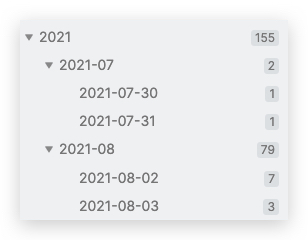Correcting Date Tags using sed in an Entire Obsidian Vault
I’ve been using Obsidian for about 8 months. It wasn’t until today that I realized I’ve been using hierarchical tags incorrectly since day one!
The Problem
In my templater templates I was using the following:
|
1 |
#<% tp.date.now("YYYY-MM-DD") %>/<% tp.date.now("YYYY-MM") %>/<% tp.date.now("YYYY") %> #<% tp.date.now("YYYY-MM-DD") %> |
The result of this is:
|
1 |
#2022-03-17/2022-03/2022 #2022-03-17 |
Unfortunately there are two problems with this. First, there is no need for that extra tag at the end; it’s already covered by the first combo tag.
Second, the hierarchy is backwards! This leads to:
|
1 2 3 4 5 6 |
├── 2022-03-16 │ └── 2022-03 │ └── 2022 └── 2022-03-17 └── 2022-03 └── 2022 |
Houston, we have a problem! What I really was after was a tag structure like this:
|
1 2 3 4 |
└── 2022 └── 2022-03 ├── 2022-03-16 └── 2022-03-17 |
The Fix
Thankfully, Obsidian stores all of the files on the filesystem natively, which means you can manipulate them using whatever tools you’d like.
Enter sed, a stream editor. Using sed and find, I was able to quickly resolve both of the issues above.
If I’d taken a little more time I would have handled both problems in one shot, but I did not. I fixed problem 2, then problem 1.
First, I cd’d into the root directory of my vault. Then…
|
1 2 3 4 5 6 7 8 9 10 11 |
# Find markdown files, feed them to sed, # edit the file "in place" (modify them directly) # We use capture groups (the parentheses) to # essentially reverse the order of the tags find . -type f -name '*.md' -print0 | xargs -0 sed -E -i "" "s/#([0-9]{4}-[0-9]{2}-[0-9]{2})\/([0-9]{4}-[0-9]{2})\/([0-9]{4})/#\3\/\2\/\1/g" # Find #YYYY/YYYY-MM/YYYY-MM-DD #YYYY-MM-DD, # capturing the first tag to "\1" # Replace with the capture group (thereby dropping the second tag) find . -type f -name '*.md' -print0 | xargs -0 sed -E -i "" "s/(#[0-9]{4}\/[0-9]{4}-[0-9]{2}\/[0-9]{4}-[0-9]{2}-[0-9]{2}) #[0-9]{4}-[0-9]{2}-[0-9]{2}/\1/g" |
Finally, I updated all of my templater templates to drop the second tag and fix the first to be in the right order.
Obsidian picked up all of the changes immediately, which were reflected in the tag pane. Much cleaner!

